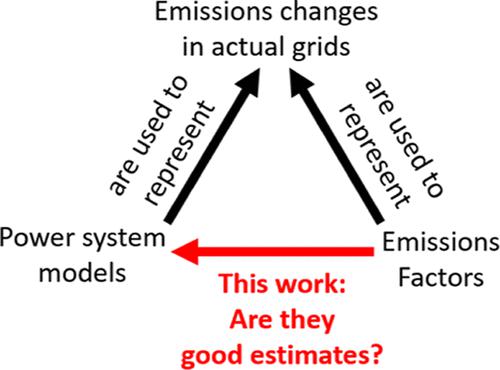当前位置:
X-MOL 学术
›
Environ. Sci. Technol.
›
论文详情
Our official English website, www.x-mol.net, welcomes your
feedback! (Note: you will need to create a separate account there.)
How Well Do Emission Factors Approximate Emission Changes from Electricity System Models?
Environmental Science & Technology ( IF 10.8 ) Pub Date : 2022-09-26 , DOI: 10.1021/acs.est.2c02344 Alejandro G N Elenes 1 , Eric Williams 1 , Eric Hittinger 2 , Naga Srujana Goteti 3
Environmental Science & Technology ( IF 10.8 ) Pub Date : 2022-09-26 , DOI: 10.1021/acs.est.2c02344 Alejandro G N Elenes 1 , Eric Williams 1 , Eric Hittinger 2 , Naga Srujana Goteti 3
Affiliation

|
Multiple forms of marginal and average emission factors have been developed to estimate the carbon emissions of adding technologies, such as electric vehicles or solar panels, to the electricity grid. Different methods can produce very different results and conclusions, indicating that choosing between methods is not trivial. Researchers would therefore like to know how well these emission factors can approximate emission changes in the actual power grid. This question remains unanswered because of the difficulty in characterizing the accuracy of these methods. Ideally, estimates would be compared to measured emission changes, but it is implausible to measure these changes on an actual grid. Instead, we propose testing these emission factor methods in a controlled environment, using an electricity system dispatch model as a reference for comparison. We find that average emission factors have lower accuracy when estimating emissions from demand shifts and observe the same for demand-based marginal emission factors at an hourly resolution. In contrast, incremental and thermal marginal emission factors can reproduce the emission changes of a power grid model under many testing conditions and scenarios. We also find that easier-to-use annual time averages offer similar results to finer time resolutions for marginal and average factors, except demand-based.
中文翻译:

排放因子对电力系统模型排放变化的近似程度如何?
已经开发了多种形式的边际和平均排放因子来估算向电网添加技术(例如电动汽车或太阳能电池板)的碳排放量。不同的方法会产生非常不同的结果和结论,这表明在方法之间进行选择并非易事。因此,研究人员想知道这些排放因子在多大程度上可以近似实际电网中的排放变化。由于难以描述这些方法的准确性,这个问题仍未得到解答。理想情况下,估计值将与测量值进行比较排放变化,但在实际电网上测量这些变化是不可信的。相反,我们建议在受控环境中测试这些排放因子方法,使用电力系统调度模型作为比较参考。我们发现平均排放因子在估算需求变化的排放时具有较低的准确性,并且在每小时分辨率下观察到基于需求的边际排放因子的准确性相同。相比之下,增量和热边际排放因子可以再现电网模型在许多测试条件和场景下的排放变化。我们还发现,除基于需求的情况外,更易于使用的年度时间平均值为边际和平均因素提供了与更精细的时间分辨率相似的结果。
更新日期:2022-09-26
中文翻译:

排放因子对电力系统模型排放变化的近似程度如何?
已经开发了多种形式的边际和平均排放因子来估算向电网添加技术(例如电动汽车或太阳能电池板)的碳排放量。不同的方法会产生非常不同的结果和结论,这表明在方法之间进行选择并非易事。因此,研究人员想知道这些排放因子在多大程度上可以近似实际电网中的排放变化。由于难以描述这些方法的准确性,这个问题仍未得到解答。理想情况下,估计值将与测量值进行比较排放变化,但在实际电网上测量这些变化是不可信的。相反,我们建议在受控环境中测试这些排放因子方法,使用电力系统调度模型作为比较参考。我们发现平均排放因子在估算需求变化的排放时具有较低的准确性,并且在每小时分辨率下观察到基于需求的边际排放因子的准确性相同。相比之下,增量和热边际排放因子可以再现电网模型在许多测试条件和场景下的排放变化。我们还发现,除基于需求的情况外,更易于使用的年度时间平均值为边际和平均因素提供了与更精细的时间分辨率相似的结果。










































 京公网安备 11010802027423号
京公网安备 11010802027423号